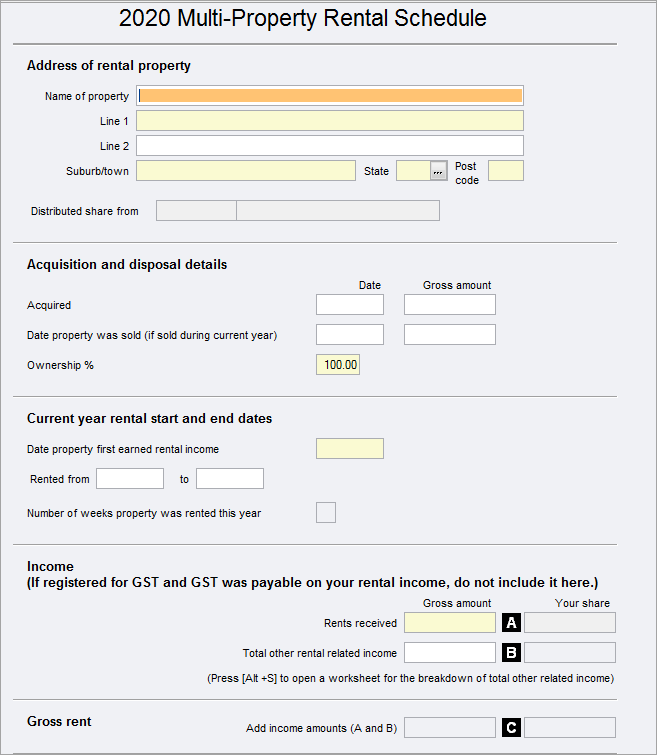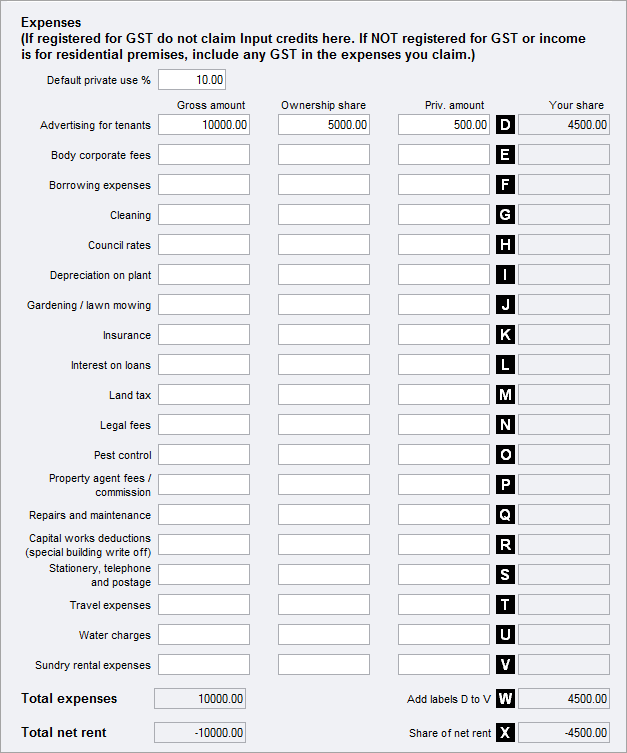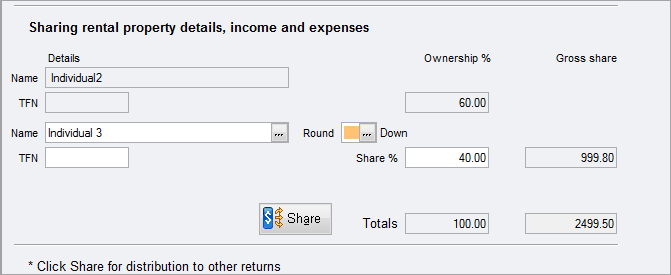Rental Income and Expenses (Individual returns only)
No deductions for vacant land
You can no longer claim tax deductions for the cost of holding vacant land, such as:
interest incurred on loans to acquire the land
land taxes
council rates
maintenance costs
These changes apply to costs incurred from 1 July 2019, even if you held the land before that date.
However, deductions for vacant land can still be claimed where, for example:
the land is used by you in a business carried on for the purpose of gaining or producing assessable income, the land is:
used or available for use in carrying on a business (for example primary production)
vacant due to an exceptional circumstance (such as fire, flood, or substantial building defects) that occurred within the last three years.
If your client is registered for GST and it was payable in relation to the rental property income, do not include the GST in the amounts shown as income in the Rental schedule. Similarly, do not include input tax credits for expenses.
If your client is not registered for GST, or the rental income was from residential premises, include any GST in the amounts claimed as expenses.
Completing the Income and Expenses
From 1 July 2020, the PLS Multi-property rental schedule (RNTLPRPTY) replaces the ATO Rental schedule (RS,) and must be lodged for Individuals owning one or more rental properties.
If you've completed more than one rental schedule, we'll combine all the details and send them to the ATO as one schedule.

| Field | Description |
|---|---|
| Address of the rental property | Enter the address of the rental property. Make sure there are no special characters in the address fields. The allowed characters are numbers, alphabets and &/'\-\(\) \*#,\.]). |
| Acquisition and disposal details | |
| Acquired | Enter the date and the purchased amount |
| Date property was sold (if sold during the current year) | Enter the date when the property was sold and the selling value. |
| Ownership % | Enter the % of ownership for this taxpayer. This is a mandatory field. You can enter decimal values in this field. For example, 33.33% |
| Current year rental start and end dates | |
| Date property first earned rental income | This is a mandatory field. |
| Rented from to | Enter the dates when the property was rented from (within the financial year) |
| Number of weeks the property was rented this year | This is a calculated field based on the dates entered in Rented from and to. (This field is not part of any calculation of income or expenses) |
| Income | |
| Rents received | Enter the Gross amount when the property is rented. Do NOT reduce this figure by deducting agent's commission or other costs. |
| Total other rental related income | Use the grid to enter other rental related income such as rental bond money, insurance compensation, letting or booking fees. This change was made as only the totals get transmitted to the ATO. |
| Your share | This is a calculated field. Your share = Gross amount x Ownership % |
| Gross rent | This is a calculated field. Label A + B. |

| Field | Description |
|---|---|
| Default private use % | Enter the private use % and click Yes if you want to default this rate for all the expenses. You can manually overwrite any expenses if the private use % is different. Use Private amount field to overwrite any amounts. |
| Gross amount | This is a mandatory field. You must enter an amount at this field if you're entering an amount at Ownership share or Private amount fields |
| Ownership share | This is a calculated field.
|
| Private Amount | This is a calculated field. You can overwrite if the % of the private use is not the same as Default private %. Private.amount cannot be greater than the ownership share field. |
| Your share | This is a calculated field. Your share = Ownership share - Private.amount. |
If the owner pre-pays a rental property expense such as insurance or interest on money borrowed, that covers a period of 12 months or less and the period ends on or before 30 June of the current income year, you can claim an immediate deduction.
A pre-payment that doesn’t meet these criteria and is $1,000 or more, may have to be spread over two or more years. This is also the case if the owner carries on the rental activity as a small business entity and has not chosen to deduct certain pre-paid expenses immediately.
Body corporate fees and charges might be incurred to cover the cost of day-to-day administration and maintenance or they may be applied to a special fund.
Payments the owner makes to body corporate administration funds and general purpose sinking funds are considered to be payments for the provision of services by the body corporate and you can claim a deduction for these levies at the time they are incurred. However, if the body corporate requires the owner to make payments to a special purpose fund to pay for particular capital expenditure, these levies are not deductible.
Similarly if the body corporate levies a special contribution for major capital expenses to be paid out of the general purpose sinking fund, you will not be entitled to a deduction for this special contribution amount. This is because payments to cover the cost of capital improvements or repairs of a capital nature are not deductible. Refer to TR 97/23 for full details.
These are expenses directly incurred in taking out a loan for the property. These would include:
Loan establishment fees,
Title search fees
Costs for preparing and filing mortgage documents, including mortgage broker fees and stamp duty charged on the mortgage
Borrowing costs also include other costs that the lender requires you to incur as a condition of them lending you the money for the property, such as:
Costs of obtaining a valuation
Lender's mortgage insurance
Interest expenses are NOT borrowing expenses.
If the total borrowing costs are more than $100, the deduction is spread over five years or the term of the loan, whichever is less. If the total borrowing costs are less than $100, they are fully deductible in the year they are incurred.
If the taxpayer took out a loan to purchase the rental property or to finance the cost of repairs or renovations to the rental property, the interest or a portion of the interest on that loan may be claimed as a deduction for the period during the income year that the property was used or held for income-producing purposes.
While the property is rented or available for rent, you may also claim interest charged on loans taken out:
to purchase depreciating assets
for repairs
for renovations
Similarly, if a loan is taken out to purchase land on which to build a rental property or to finance renovations to a property the owner intends to rent out, the interest on the loan will be deductible from the time the loan was taken out. However, if the owner’s intention changes - for example, a decision is made to use the property for private purposes and it is no longer used or intended to be used to produce assessable income, you cannot continue to claim the interest after the owner’s intention changes.
Banks and other financial institutions offer a range of financial products that can be used to acquire a rental property. Many of these products permit flexible repayment and redraw facilities. As a consequence, a loan might be obtained to purchase both property and, say, a private car. In this case, the interest on the loan must be apportioned into the deductible and non-deductible parts according to the amounts borrowed for each.
If the taxpayer has a loan account that has a fluctuating balance due to a variety of deposits and withdrawals and it is used for both private reasons and rental property purposes, the owner must keep accurate records to enable you to calculate the interest that applies to the rental property portion of the loan; that is you must separate the interest that relates to the property from any interest that relates to the private use of the funds.
Some rental property owners borrow money to buy a new home and then rent out their previous home. If there is an outstanding loan on the old home and the property is used to produce income, the interest outstanding on the loan, or part of the interest, will be deductible. However, an interest deduction cannot be claimed on the loan used to buy the new home because it is not used to produce income. This is the case whether or not the loan for the new home is secured against the former home.
Thin Capitalisation: If the owner is an Australian resident and he, or any associate entities, has certain overseas interests or if the owner is a foreign resident, thin capitalisation rules might apply if the debt deductions – such as interest (combined with those of the taxpayer’s associate entities) for example, for 2007-08 are more than $250,000 you may only be able to claim a reduced amount. Refer to the Thin Capitalisation guide (NAT 4461).
Borrowing expenses that are directly incurred in purchasing the property are not interest expenses and should be claimed at label F.
Some legal expenses incurred in earning rental income are deductible, but most are of a capital nature.
Include such legal expenses as incurred in evicting a non-paying tenant or recovering unpaid rent.
Do NOT include costs incurred in:
purchasing or selling the property,
resisting land resumption, or
defending title to the property
Such expenses are non-deductible and must be capitalised. Non-deductible expenses however may form part of the cost base of the property for Capital gains tax purposes.
Expenditure for repairs and maintenance may be deductible. However, the repairs must relate directly to wear and tear or other damage that occurred as a result of the owner renting out the property.
Repairs generally involve a replacement or renewal of a worn out or broken part – for example, replace some guttering damaged in a storm or part of a fence that was damaged by a falling tree branch.
The following deductions are capital in nature and therefore not deductible:
replacement of an entire structure or unit of property (such as a complete fence or building, a stove, kitchen cupboards or a refrigerator)
improvements, renovations, extensions and alterations, and
initial repairs – for example, remedying defects, damage or deterioration that existed at the date the property was purchased.
You may be able to claim capital works deductions for these expenses. Refer to the information at Label R - Capital works deductions below.
You may be able to claim certain kinds of construction expenditure. In the case of residential rental properties, the deduction would be spread over a period of 25 to 40 years. Total capital works deductions cannot exceed the construction expenditure and no deduction is available until the construction is complete.
Deductions based on construction expenditure apply to capital works such as:
a building or extension - for example, adding a room, garage, patio or pergola
alterations, such as removing or adding an internal wall, or
structural improvements to the property – for example, adding a gazebo, carport, sealed driveway retaining wall or fence.
You can only claim deductions for the period during the year that the property was rented or is available to rent.
If you can claim capital works deductions, the construction expenditure on which those deductions are based cannot be taken into account in working out any other types of deductions for decline in value of depreciating assets.
The amount of deduction you can claim depends on the type of construction and the date construction started. For more information click this link to the ATO website.
Only those expenses incurred in travelling to inspect or maintain the property or to collect rent are deductible. If the taxpayer combines this travel with travel for private purposes, the expense will need to be apportioned.
Net Rent: This is the result of Rental income less expenses and is calculated by the system.
Mortgage discharge expenses are the costs involved in discharging a mortgage other than payments of principal and interest. These costs are deductible in the year they are incurred to the extent that the owner took out the mortgage as security for the repayment of money borrowed to use to produce assessable income.
For example, if the owner used the property to produce rental income for half the time he held it and as a holiday home half of the time, 50% of the costs of discharging the mortgage are deductible.
Mortgage discharge expenses may also penalty interest payments. Penalty interest rates are amounts paid to a lender, such as a bank, to agree to accept early repayment of a loan, including a loan on a rental property. The amounts are commonly calculated by reference to the number of months that interest payments would have been made had the premature repayment not been made.
Penalty interest payments on a loan relating to a rental property are deductible if:
if the loan money borrowed are secured by a mortgage over the property and the payment effects the discharge of the mortgage, or
payment is made in order to rid the taxpayer of a recurring obligation to pay interest on the loan.
The owner’s share of the costs of preparing and registering a lease and the cost of stamp duty on a lease are deductible to the extent that the owner has used, or will use the property to produce income. This includes any such costs associated with an assignment or surrender of a lease.
This is the area of the worksheet where the details of co-owners of the property are entered, together with the share of the Net Rental Income each is to receive:

| Name, TFN, Ownership %, Gross share | There are 2 sets of these 4 fields. The first set is reserved for the Host return and is set with the details of the taxpayer. The ownership % is pre-filled from the ownership % field in the Acquisition and disposal details section. To complete the second owner,
To add another owner, press Ctrl + Insert to add a record. After you've entered all the details, click Share. |
| Round | Rounding may be necessary where the income to be shared results in uneven amounts. The default method applied in this schedule is Natural rounding: Click [F10] to display an index of rounding methods.
|
| Gross Share | This field is automatically calculated by Tax applying the % Share entered for the owner or co-owner to the Net income available for sharing |
| Share | Click the Share button after you've entered the Share %. This will calculate Totals field. If you make any change to the income, expenses, or ownership %, make sure to click Share for the Totals to update. |
For Accountants Enterprise and Series 6 & 8, when apportionment of income and expenses varies on an ad hoc basis between co-owners, click [F5] to copy the original schedule to the other owners, and edit each according to requirements.
When re-copying a rental schedule, the destination return's original copy will be overwritten if the address matches exactly that of the rental property already on file for the destination return. This avoids accidentally adding more than one schedule for the same property.

